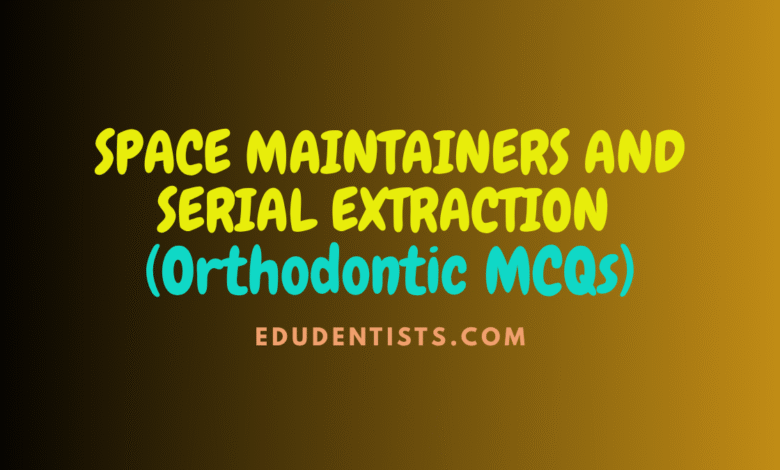
SPACE MAINTAINERS AND SERIAL EXTRACTION
SPACE MAINTAINERS AND SERIAL EXTRACTION
1. A dentist finds an 8-year-old boy with all primary molars present, which exhibits a cusp to cusp relation of permanent maxillary and mandibular first molars. What should be the treatment plan for this case?
A. Regular recalls
B. Referral to an orthodontist for consultation
C. Plan for a serial extraction, for more normal adjustments of occlusion
D. Use of cervical headgear to reposition maxillary molars
E. Proximal disking of distal surfaces of primary mandibular second molars to permit normal adjustment of permanent molars
2. Which one of the following conditions is usually seen in a class II division 2 malocclusion?
A. Open bite
B. Steep mandibular plane
C. Mesio-occlusion of permanent first molar
D. Lingual inclination of maxillary central incisors
3. Wilkinson’s extraction is carried out at the age of:
A. 7½–8½ years
B. 8½–9½ years
C. 9½–10½ years
D. 10½–11½ years
4. A 9-year-old boy has been observed with the following findings:
– Crowding of mandibular anterior teeth
– An end-to-end molar relationship
– Class II facial profile
– The mixed dentition analysis shows a 4.4 mm TSALD in the mandible.
Which of the following is the ideal management of this patient at this time?
A. Referral to an orthodontist for consultation
B. Start a serial extraction program to create room for posterior teeth
C. Removal of mandibular lateral incisor to allow crowded anterior teeth to align themselves
D. Do nothing because the probability is good that the child’s apparent malocclusion is a transitional stage and future growth spurts will correct the problem.
5. A space maintainer is least indicated, when there is a premature loss of a:
A. Permanent max. C.I
B. Primary max. first molar
C. Primary max. C.I
D. Primary man. First molar.
6. A 9-year-old patient shows a lingually locked permanent maxillary left central incisor. Supporting bone is intact and in harmony with tooth size. Other relationships are normal without any basic discrepancies. What could be the possible etiological feature?
A. Premature extraction of the primary maxillary right central incisor
B. Prolonged retention of the primary maxillary left central incisor
C. Premature extraction of the primary maxillary left central incisor with space loss in the area
D. Pronounced facioversion on eruption of the permanent mandibular left central incisor
7. A 10-year-old girl comes for examination immediately after losing a primary mandibular second molar with otherwise clinically normal occlusion. What should the dentist do?
A. Observe the patient
B. Place a lingual arch space maintainer
C. Place a functional space maintainer
D. Base his choice of treatment upon radiographic findings
8. In a 5-year-old child, how will the extraction of a primary maxillary central incisor with incisal spacing affect the size of the intercanine space?
A. The intercanine space will increase in size
B. The intercanine space will decrease in size
C. The intercanine space will not change
9. Common cause of severe mandibular incisor crowding is:
A. Mesial migration of teeth
B. Premature loss of primary teeth
C. Presence of supernumerary teeth
D. Tooth size arch length discrepancy
10. A distal shoe space maintainer is indicated when a primary:
A. Incisor is avulsed
B. First molar is prematurely lost
C. Second molar is lost after eruption of a permanent first molar
D. Second molar is lost before eruption of a permanent first molar
11. Following an accident, an 8-year-old girl lost both maxillary central incisors. What would be the ideal treatment option?
A. Observe the patient
B. Move the L.I into C.I position
C. Construct and place a space maintainer with bands cemented on L.I
D. Place a temporary prosthesis supplying artificial crowns for the lost central incisors
12. Premature exfoliation of a primary canine may indicate:
A. An arch length excess
B. An arch length deficiency
C. A skeletal malocclusion
D. None of the above
13. The best space maintainer among the following is:
A. A Nance holding arch
B. A fixed lingual arch
C. A pulpectomized primary molar
D. A Band and loop appliance
14. A mixed dentition 10-year-old patient has a cusp to cusp molar relationship. This will probably become a Class I molar relation by:
A. The maxillary molar drifting posteriorly 0.9 mm
B. The mandibular molar drifting forward 3.4 mm
C. Both molars drifting forward with the mandibular molar drifting about twice as far as the maxillary molar
D. Orthodontic intervention only
15. A substantial increase in width of maxillary arch is usually best achieved by placing:
A. Lingual arch wires
B. A sutural-expansion fixed appliance
C. Posterior intermaxillary cross elastic bands
D. A face–bow headgear with an expanded inner bow
16. Space maintainers are usually needed in which area?
A. Mandibular primary incisor teeth area
B. Maxillary primary incisor teeth area
C. Mandibular primary second molar teeth area
D. Mandibular primary canine teeth area
17. Indication of serial extraction
A. Arch perimeter–tooth material discrepancy
B. Spaced dentition
C. Skeletal abnormalities
D. None of the above
18. The Dewel’s (usual) regimen followed in serial extraction is
A. C D 4
B. 4 D C
C. C 4 D
D. D C 4
19. The Tweed’s method followed in serial extraction is:
A. C D 4
B. D 4 C
C. C 4 D
D. 4 C D
20. The Nance method followed in serial extraction is
A. D 4 C
B. C D 4
C. 4 C D
D. C D 4
21. During serial extraction procedures, the most critical observation is during the eruption of:
A. Primary second molar
B. Permanent maxillary molar
C. Permanent mandibular canine and first premolar
D. Permanent mandibular incisors and canines
22. In which arch is the modified Dewel’s method of serial extraction usually carried out?
A. Maxillary arch
B. Mandibular arch
C. Upper anterior region
D. None of above
23. Balancing extraction refers to removal of tooth in:
A. Opposing arch
B. Opposite side of the same arch
C. Extraction in both upper and lower arches
D. None of the above
24. Which of the following is a contraindication of Distal shoe space maintainer?
A. Patients with SABE
B. Immunocompromised patients
C. Congenitally missing first molar
D. All of above
25. Which of the following is a modification of band and loop space maintainer?
A. Holtz appliance
B. Mayne appliance
C. Herbst appliance
D. Gerber appliance
26. Who termed serial extraction as, “Active supervision of teeth by extraction”?
A. Bunon
B. Kjellgren
C. Hayes Nance
D. Rudolph Holtz
27. Nance palatal arch is a:
A. Bilateral, nonfunctional
B. Unilateral, functional
C. Bilateral, functional
D. Unilateral, nonfunctional
28. The term “Timely extraction” was given by
A. Stemm
B. Willet
C. Mayne
D. Wilkinson
29. In case of primary dentition, which of the following problems require most active tooth movement?
A. Transverse
B. Vertical
C. Sagittal
D. All of above
30. Which of the following orthodontic categories involves occlusal adjustment of teeth through judicious grinding?
A. Corrective orthodontics
B. Interceptive orthodontics
C. Preventive orthodontics
D. Surgical orthodontics





